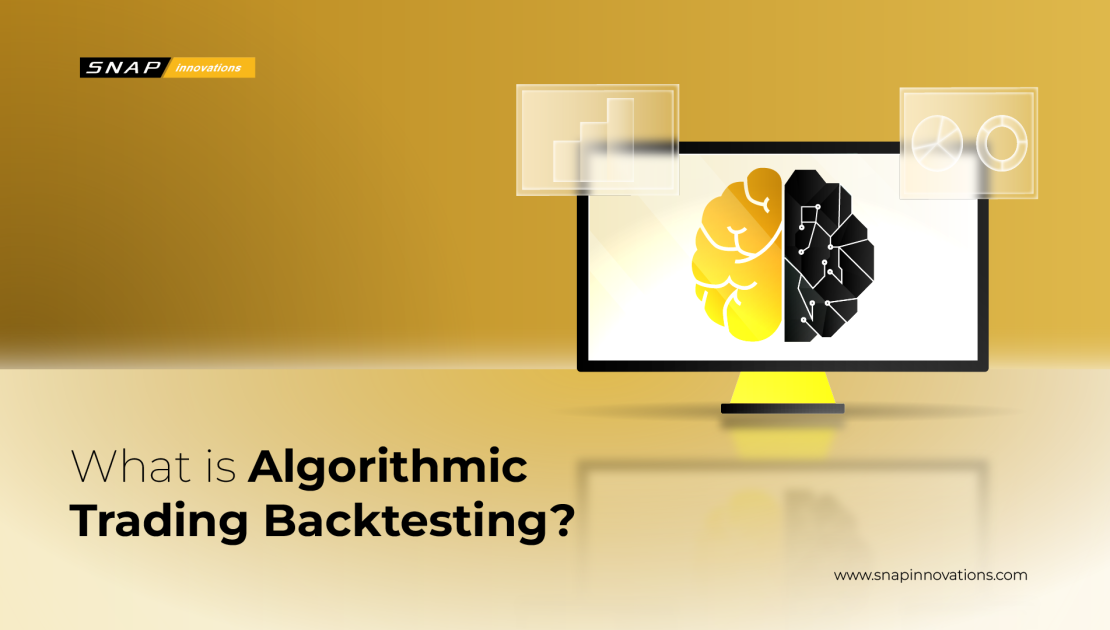The Power of Algorithmic Trading Backtesting

Algorithmic trading, also known as algo trading, has transformed financial markets by automating the execution of trades based on predefined algorithms and rules. It relies on computer programs to analyze market data, identify trading opportunities, and execute orders at optimal prices and timings. In this digital age, where milliseconds can make a difference, algo trading offers speed, efficiency, and precision that traditional manual trading cannot match.
A crucial component of algorithmic trading is backtesting, a process used to evaluate the performance of trading strategies using historical market data. Backtesting allows traders to assess how a particular strategy would have performed in the past, providing insights into its profitability, risk exposure, and overall effectiveness. By simulating trades under historical conditions, traders can identify strengths, weaknesses, and areas for improvement in their strategies before deploying them in live markets.
What is Algo Trading Backtesting?
Backtesting serves multiple purposes in algo trading. Firstly, it helps traders validate the viability of their trading strategies by quantifying their historical performance metrics such as profit and loss, win rate, and drawdown. Secondly, it allows traders to fine-tune their strategies by adjusting parameters, optimizing entry and exit rules, or exploring alternative trading approaches. Thirdly, backtesting provides a means to assess the impact of external factors such as market volatility, liquidity, and transaction costs on strategy performance.
However, backtesting is not a foolproof process and comes with its own set of challenges and limitations. One of the primary challenges is data quality and accuracy. The reliability of backtesting results hinges on the integrity of historical market data used for simulation. Inaccurate or incomplete data can lead to biased results, misinterpretation of strategy performance, and suboptimal decision-making. Therefore, traders must ensure they have access to high-quality, clean historical data sourced from reputable providers.
Read More: Open Outcry Trading: A Comprehensive Guide
Another challenge in backtesting is the risk of overfitting, a phenomenon where a trading strategy performs exceptionally well on historical data but fails to generalize to unseen market conditions. Overfitting occurs when traders optimize their strategies excessively to fit past data patterns, resulting in models that are too complex and specific to historical market conditions. To mitigate the risk of overfitting, traders should use robust validation techniques, such as out-of-sample testing, cross-validation, and sensitivity analysis, to assess the generalizability and robustness of their strategies.
Furthermore, backtesting results can be sensitive to factors such as transaction costs, slippage, and market impact, which are often overlooked or underestimated. Transaction costs, including brokerage fees, exchange fees, and bid-ask spreads, can significantly affect strategy profitability, especially for high-frequency trading strategies that involve frequent trades. Slippage, the difference between expected and actual execution prices, can erode trading profits and distort backtesting results if not properly accounted for. Market impact, the effect of large trades on market prices, can also influence strategy performance and execution dynamics, particularly in illiquid or thinly traded markets.
Despite these challenges, backtesting remains an indispensable tool for algo traders seeking to develop, refine, and optimize their trading strategies. By following best practices, leveraging high-quality data, avoiding overfitting, and accounting for transaction costs and market dynamics, traders can harness the power of backtesting to gain a competitive edge in financial markets.
The Significance of Backtesting in Algo Trading
 Backtesting is a critical component of algorithmic trading, providing traders with a systematic approach to evaluate the performance of their trading strategies using historical market data. It serves as a valuable tool for validating the viability, effectiveness, and robustness of trading strategies before deploying them in live markets. By simulating trades under past market conditions, backtesting enables traders to quantify the potential risks and rewards associated with their strategies, identify strengths and weaknesses, and make informed decisions about strategy optimization and deployment.
Backtesting is a critical component of algorithmic trading, providing traders with a systematic approach to evaluate the performance of their trading strategies using historical market data. It serves as a valuable tool for validating the viability, effectiveness, and robustness of trading strategies before deploying them in live markets. By simulating trades under past market conditions, backtesting enables traders to quantify the potential risks and rewards associated with their strategies, identify strengths and weaknesses, and make informed decisions about strategy optimization and deployment.
The significance of backtesting in algo trading can be understood from several perspectives. Firstly, it helps traders gain confidence in their strategies by providing empirical evidence of their historical performance. By quantifying key performance metrics such as profit and loss, win rate, maximum drawdown, and risk-adjusted returns, backtesting allows traders to assess the profitability and risk exposure of their strategies objectively. This, in turn, enables traders to make informed decisions about strategy selection, allocation of capital, and risk management.
Secondly, backtesting serves as a tool for strategy refinement and optimization. By analyzing the results of backtesting experiments, traders can identify areas for improvement in their strategies, such as optimizing entry and exit rules, adjusting position sizing parameters, or incorporating additional filters and criteria. Through iterative testing and refinement, traders can enhance the performance and robustness of their strategies, thereby increasing their chances of success in live markets.
Thirdly, backtesting provides a means to assess the impact of market dynamics and external factors on strategy performance. By simulating trades under different market conditions, such as varying levels of volatility, liquidity, and transaction costs, traders can gain insights into how their strategies perform under adverse conditions and identify potential vulnerabilities or limitations. This helps traders develop risk mitigation strategies, adapt their trading approaches to changing market conditions, and build resilience against unexpected events or market shocks.
Moreover, backtesting facilitates objective decision-making and risk management by providing traders with quantifiable data and performance metrics. By comparing the results of multiple backtesting experiments and scenarios, traders can evaluate the relative merits of different strategies, assess their risk-return profiles, and make informed decisions about strategy selection, optimization, and deployment. This helps traders avoid emotional bias, cognitive errors, and impulsive decision-making, thereby enhancing their discipline and consistency in trading.
Overall, backtesting plays a crucial role in the development, validation, and optimization of trading strategies in algorithmic trading. By providing traders with empirical evidence of strategy performance, facilitating strategy refinement and optimization, assessing the impact of market dynamics and external factors, and enabling objective decision-making and risk management, backtesting empowers traders to make informed decisions and achieve their trading objectives effectively.
Methodologies of Algo Trading Backtesting
 Algo trading backtesting encompasses various methodologies and techniques for evaluating the performance of trading strategies using historical market data. Each methodology has its advantages, limitations, and suitability for different types of strategies and market conditions. Understanding the different backtesting methodologies is essential for traders to effectively assess the viability, effectiveness, and robustness of their strategies and make informed decisions about strategy optimization and deployment.
Algo trading backtesting encompasses various methodologies and techniques for evaluating the performance of trading strategies using historical market data. Each methodology has its advantages, limitations, and suitability for different types of strategies and market conditions. Understanding the different backtesting methodologies is essential for traders to effectively assess the viability, effectiveness, and robustness of their strategies and make informed decisions about strategy optimization and deployment.
Event-Driven Backtesting
One common approach to algo trading backtesting is event-driven backtesting, where trades are executed based on predefined events or signals derived from historical data. In event-driven backtesting, traders specify criteria or conditions for entering and exiting trades, such as moving average crossovers, breakout patterns, or momentum indicators. The backtesting engine then scans historical market data for occurrences of these events, simulates trades accordingly, and calculates the resulting profit and loss.
Event-driven backtesting offers several advantages, including flexibility, simplicity, and ease of implementation. Traders can easily define and customize trading rules and criteria based on their preferences, trading style, and market outlook. Moreover, event-driven backtesting allows traders to simulate trades in real-time or replay mode, enabling them to test their strategies under different market conditions and timeframes. However, event-driven backtesting may suffer from limitations such as lookahead bias, where future information is inadvertently used to make trading decisions, and survivorship bias, where only successful strategies are considered in the analysis.
Vectorized Backtesting
Another approach to algo trading backtesting is vectorized backtesting, which leverages efficient data processing techniques to simulate trades across a large dataset swiftly. In vectorized backtesting, trading strategies are implemented using vectorized operations and parallel processing, allowing for faster execution and analysis of trades compared to traditional event-driven approaches. By optimizing computational resources and minimizing processing overhead, vectorized backtesting enables traders to conduct comprehensive strategy testing and optimization within shorter timeframes.
Vectorized backtesting is particularly well-suited for high-frequency trading strategies that involve rapid decision-making and execution. By harnessing the power of modern computing technologies such as multi-core processors, graphical processing units (GPUs), and cloud computing platforms, traders can analyze vast amounts of historical market data and iterate on their strategies efficiently. However, vectorized backtesting may require advanced programming skills and infrastructure investments to implement effectively, limiting its accessibility to novice traders and small-scale investors.
Monte Carlo Simulation
Monte Carlo simulation is another technique used in algo trading backtesting to assess the robustness and variability of trading strategies under different market scenarios. In Monte Carlo simulation, random samples of market data are generated based on statistical distributions and parameters derived from historical data. These simulated datasets are then used to evaluate the performance of trading strategies and estimate their potential outcomes across a range of market conditions.
Monte Carlo simulation offers several benefits for algo trading backtesting, including the ability to quantify risk and uncertainty, identify outliers and extreme events, and assess strategy performance under diverse market conditions. By generating multiple random scenarios and analyzing their outcomes, traders can gain insights into the sensitivity of their strategies to changes in market dynamics, parameter values, and assumptions. However, Monte Carlo simulation requires significant computational resources and may introduce additional complexities and uncertainties into the backtesting process, requiring careful interpretation and validation of results.
Walk-Forward Optimization
Walk-forward optimization is a dynamic approach to algo trading backtesting that combines in-sample and out-of-sample testing to continuously adapt and refine trading strategies over time. In walk-forward optimization, the backtesting period is divided into multiple segments or intervals, with each segment used for parameter optimization and validation. After optimizing the strategy parameters using historical data from the in-sample period, the strategy is tested on out-of-sample data from the subsequent interval to assess its performance and generalizability.
Walk-forward optimization offers several advantages over traditional static backtesting approaches, including adaptability, robustness, and responsiveness to changing market conditions. By periodically re-optimizing and validating trading strategies using recent data, traders can adapt to evolving market dynamics, minimize the impact of overfitting, and maintain competitiveness and profitability over the long term. However, walk-forward optimization requires careful design and implementation to prevent data mining bias and ensure the integrity and reliability of results.
Machine Learning and AI-Based Backtesting
Machine learning and artificial intelligence (AI) techniques are increasingly being used in algo trading backtesting to develop predictive models, optimize trading strategies, and improve decision-making processes. Machine learning algorithms such as neural networks, support vector machines, and random forests can analyze vast amounts of historical market data, identify complex patterns and relationships, and generate predictive insights into future market movements.
Machine learning-based backtesting offers several advantages, including the ability to discover non-linear patterns, adapt to changing market conditions, and exploit hidden opportunities that may not be apparent to human traders. By incorporating machine learning models into the backtesting process, traders can enhance the predictive accuracy and robustness of their strategies, optimize trading parameters dynamically, and achieve superior risk-adjusted returns. However, machine learning-based backtesting also poses challenges such as model interpretability, data scarcity, and computational complexity, requiring careful validation and risk management measures.
Challenges and Pitfalls in Backtesting
 While backtesting serves as a crucial tool for evaluating trading strategies in algo trading, it is not without its challenges and pitfalls. Traders must be aware of these challenges to interpret backtesting results accurately, avoid common pitfalls, and make informed decisions about strategy development and deployment.
While backtesting serves as a crucial tool for evaluating trading strategies in algo trading, it is not without its challenges and pitfalls. Traders must be aware of these challenges to interpret backtesting results accurately, avoid common pitfalls, and make informed decisions about strategy development and deployment.
Data Quality and Accuracy
One of the primary challenges in backtesting is ensuring the quality and accuracy of historical market data. Backtesting results heavily rely on the integrity of the data used for simulation, including price, volume, and order book data. Inaccurate or incomplete data can lead to biased results, misinterpretation of strategy performance, and suboptimal decision-making. Traders must source high-quality, clean historical data from reputable providers and perform thorough data validation and cleansing processes to mitigate this risk.
Overfitting and Data Snooping Bias
Overfitting is a significant risk in backtesting, where a trading strategy performs exceptionally well on historical data but fails to generalize to unseen market conditions. Overfitting occurs when traders optimize their strategies excessively to fit past data patterns, resulting in models that are too complex and specific to historical market conditions. Traders must guard against overfitting by using robust validation techniques, such as out-of-sample testing, cross-validation, and sensitivity analysis, to assess the generalizability and robustness of their strategies. Data snooping bias, which arises from repeatedly testing hypotheses on the same dataset, can exacerbate overfitting and lead to false discoveries. Traders must be mindful of this bias and adjust their validation methods accordingly.
Transaction Costs and Slippage
Transaction costs, including brokerage fees, exchange fees, and bid-ask spreads, can significantly impact strategy performance and profitability, especially for high-frequency trading strategies that involve frequent trades. Slippage, the difference between expected and actual execution prices, can further erode trading profits and distort backtesting results if not properly accounted for. Traders must accurately model transaction costs and slippage in their backtesting simulations to reflect real-world trading conditions and ensure realistic performance estimates.
Read Next: Top 10 Options Exchanges to Know in 2024
Market Dynamics and Regime Changes
Backtesting results can be sensitive to changes in market dynamics, such as shifts in volatility, liquidity, and market regime. Strategies that perform well under one set of market conditions may falter or underperform in different environments. Traders must assess the robustness of their strategies by testing them across various market regimes and adapting their approaches to changing market conditions. Moreover, unexpected events or structural changes in financial markets can invalidate backtesting assumptions and render historical performance irrelevant. Traders must stay vigilant and continuously monitor market dynamics to adjust their strategies accordingly.
Psychological Biases and Behavioral Factors
Psychological biases and behavioral factors can influence backtesting decisions and distort interpretation of results. Confirmation bias, overconfidence, and hindsight bias are common psychological pitfalls that can lead traders to misinterpret backtesting outcomes, ignore warning signs, or overlook potential risks. Traders must cultivate self-awareness, discipline, and objectivity in their backtesting process to mitigate the impact of these biases and make rational, data-driven decisions.
Conclusion
In the fast-paced and dynamic world of algorithmic trading, backtesting stands as a crucial pillar upon which successful strategies are built. Through meticulous analysis of historical market data, traders gain invaluable insights into the performance, viability, and robustness of their trading algorithms. However, the journey of backtesting is fraught with challenges and pitfalls, from data quality issues to the risk of overfitting and the ever-changing landscape of financial markets.
Despite these challenges, adopting best practices can significantly enhance the reliability and effectiveness of backtesting results. By sourcing high-quality data, incorporating realistic transaction costs and slippage parameters, validating strategies with out-of-sample testing, and continuously monitoring market dynamics, traders can navigate the complexities of algorithmic trading with greater confidence and precision.
